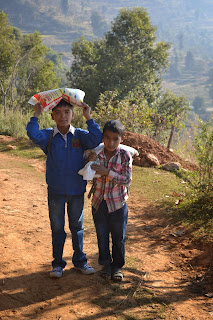8 September
…Otherwise known as the festival where I was pushed on stage
to dance in front of the entire village of Gorkha and interviewed for the local
radio station. In Nepali, of course!

It began with a 5am start Saturday morning when my baujyu
ushered me out of bed to begin preparation for the Teej women’s festival.
Wrapped, re-wrapped, and re-re-wrapped in a bright red sari, I had a firsthand
account of how my Barbie dolls used to feel as I was primped, pinned, and
prodded by every member of the family, who each had their own opinion of how
the drape should fold and skirt should tuck. Just when I thought I was ready to
go, my dai rushed in with a bag of hair supplies. An hour later, he had fixed
me a beautiful prom-worthy hairstyle that required more bobby pins than I used
for my junior and senior formals. Combined. I donned a bunch of borrowed gold
jewelry (so much so that I was not allowed to walk around by myself in case I
was mugged. Very subtle.) and was ready for the walk to the NELTA office, where
the ETAs assist with extra English programs and cultural activities. And Teej
was a cultural event we were told we didn’t want to miss.

Once a year, Nepali women return to their mighty garr (maternal homes) and
celebrate with singing, dancing, and showing off their finest outfits. Oh, and
fasting. It is customary for women to spend the day fasting for the long life
of their husbands and after 3 weeks of mountains of rice, I was ready to
welcome the short reprieve. I was informed that morning, however, my family
does not practice that tradition when a bigger than usual rice peak arrived on
the table in front of me. Apologies to my future husband –looks like you’re not
off the hook for exercising and healthy eating…
We spent the day dancing with our students, feasting on Teej
dar (rice pudding and vegetable
curry) before returning home to rest and repeat the next day. Following the
throngs of elegantly dressed women to the nearby temple, my didi and I passed
some of my students along the way.
“Raamro nacchnu! Dheri dheri raamro nacchnu,” they all
giggled, pointing at me. “Beautiful dancing.”
Why, thank you, I thought. This caused my didi to speak
enthusiastically (read: so quickly it was beyond comprehension) although I was
able to catch bits and pieces. Dancing. Stage. Camera. Photo. America.
Yes, I thought. I’m definitely going to take plenty of
photos to show my family and friends at home.
Ten minutes later when I found myself being pulled onto the stage, I realized that my
translation had been a bit off… I was
the one that would be dancing on stage. When the split-second moment of panic
wore off, I pretended I knew what I was doing and mimicked the dancers around
me –then added in some moves of my own. (If you see any future Nepali music
videos featuring moves that look suspiciously like the Macarana with a few
wrist flicks and hip shakes, you can probably guess why…)
Smiling and sweating, I made my way to the stage steps once
the music finally slowed. But before I could escape to freedom, the MC grabbed
my arm and pushed a microphone at my face.
“Just a few questions,” her voice crackled over a dozen
loudspeakers positioned around the grounds. “Can you tell us you’re name, where
you’re from and how you like the Teej festival?”

I silently thanked Prava-ji for her month of language
training and the ability to respond in Nepali.
“Mero naam Amisha Shrestha ho ra mero desh America ho. Yo
dheri dheri raamilo chaa!”
Even hours later, Didi was still laughing and showing me off
to everyone we passed. “FM radio! FM radio!” she called out, again pointing to
me. Not only did all of Gorkha witness my dancing, but for anyone missing out
at home, they could tune into my radio interview. And that, ladies and
gentlemen, is how one slightly confused and overwhelmed, yet excited American got
her Nepali claim to fame!



































